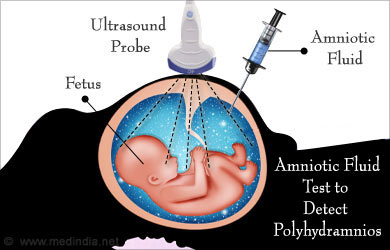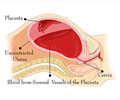- D C Dutta's Textbook of Obstetrics - 8th edition
- Polyhydramnios - (http://radiopaedia.org/articles/polyhydramnios)
What is Polyhydramnios?
Polyhydramnios or hydramniosis defined as a condition where the fluid in the amniotic sac surrounding the fetus becomes more than 2000mL. The normal maximum amount of amniotic fluid is 800ml, which is noted at 34 weeks of pregnancy. This amount further decreases as the pregnancy progresses and is around 600 ml at 40 weeks.
In polyhydramnios, the excess fluid causes a large abdomen, which may cause discomfort to the mother. It may also make it difficult for the doctor to estimate the position of baby by physical examination, necessitating the use of sonography.
Polyhydramnios is more common in women who have given birth many a times before than in women who are going to have their first child. It may be acute, occurring over a few days, or chronic, occurring over a few weeks. This article mainly describes chronic polyhydramnios.

What are the Causes of Polyhydramnios?
In many cases, the cause of polyhydramnios is not known. In others, polyhydramnios may be due to fetal, maternal or placental causes.
- Fetal causes: Since the fetus normally swallows amniotic fluid, fetal malformations are associated with polyhydramnios. These include:
- Genetic abnormalities like abnormal number of chromosomes
- Neural tube defects which result in conditions like anencephaly, where the brain is not developed, and openspina bifida, a Birth Disorder, where the spinal cord is not well developed
- Inability of the fetus to swallow amniotic fluid due to facial clefts, neck masses and developmental problems of the food pipe and the duodenum, the first part of the intestine
- Hydrops fetalis, where there is an accumulation of fluid in two or more areas of the fetus like the scalp, around the lungs and heart, and in the abdominal cavity. It may occur due to Rh blood mismatch between the mother and the fetus, or several other problems
- Placental causes: A tumor of the placenta called chorioangioma causes polyhydramnios. It leads to excessive secretion of amniotic fluid.
- Maternal causes:
- Uncontrolled diabetes in the mother causes an increase in the level of fetal blood sugar. This leads to excessive urination by the fetus, thereby causing an increase in the amniotic fluid.
- Renal Heart or kidney disease carrying Presence of more than one fetuses like twins or triplets.
What are the Symptoms and Signs of Polyhydramnios?
Symptoms and signs of polyhydramnios include the following:
- Breathlessness while lying down
- Palpitation that is, hearing or feeling one’s own heartbeat.
- Due to pressure from the large uterus, the patient may develop swelling of legs, varicose veins in the legs and piles
- Abdomen is larger than normal for the particular duration of pregnancy and the skin appears excessively stretched. The physician is unable to feel the fetal parts or hear the fetal heartbeats with a stethoscope.

How to Diagnose Polyhydramnios?
Diagnosis of polyhydramnios is made based on:
- Ultrasound: Ultrasound is the method of choice to detect polyhydramnios. It is also helpful to detect multiple fetuses, fetal position or congenital anomalies if any.
- Blood tests: ABO and Rh blood grouping is done since, Rh mismatches can give rise to hydrops fetalis. Blood sugar levels are also measured to detect diabetes in the mother.
- Amniotic fluid tests: Estimation of alpha-fetoprotein in the amniotic fluid is done to find out congenital malformation. It is markedly increased if the fetus has an open neural tube defect.

What are the Complications of Polyhydramnios?
Complications of polyhydramnios include:
- Increased blood pressure during pregnancy which may lead to pre-eclampsia
- Abnormal fetal position, making delivery difficult
- Early rupture of membranes leading to preterm labor and premature baby
- Prolapse of the umbilical cord during delivery, which can result in reduced blood supply to the baby
- Excessive bleeding during and after delivery
- Increased fetal deaths due to prematurity and congenital abnormality.
What is the Treatment of Polyhydramnios?
Treatment of polyhydramnios depends on the extent of the condition and the underlying cause.
Mild polyhydramnios that develops around the middle of pregnancy usually reduces by itself without treatment. Bed rest is advised for a few days.
Severe polyhydramnios is treated in the hospital. A severe fetal malformation may warrant immediate delivery. If no fetal malformation is present, the mother is advised bed rest and is administered indomethacin to decrease fetal urinary output. Excessive amniotic fluid is removed at regular intervals in a controlled manner by a process called amniocentesis. If the pregnancy is more than 37 weeks, amniocentesis is followed by delivery of the fetus.
How can Polyhydramnios be prevented?
Polyhydramnios can be prevented to some extent by:
- Early detection and control of maternal diabetes

- Genetic counseling to reduce the chances of fetal malformations
- Administering anti-D immunoglobulin to Rh negative mother within 72 hours of birth of a Rh-positive fetus to prevent hydrops fetalis in subsequent pregnancies










